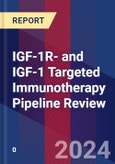This product provides basic information on approved drugs and immunotherapy candidates in research and development targeting insulin-like growth factor-1 (IGF-1) or its receptor (IGF-1R).
This product consists of:
- Competitors described in a tabular format covering drug code/INN, target(s)/MoA, class of compound, territory of main competitor, indication(s) & R&D stage.
- Project History with link to source of information (press release, homepage, abstracts, presentations, annual reports etc).
- This product is delivered on the very same day of purchase by e-mail containing competitor and project history reports in pdf format and database credentials. Reports are prepared on the same day.
IGF-1R is a key member of the insulin-like growth factor (IGF) axis, which involves in cancer development, metastasis and cancer therapeutic resistance. Anti-IGF-1R monoclonal antibody is among the first major therapeutic agents for IGF-1R inhibition. These antibodies inhibit the binding between IGF-1R and its ligands, thereby blocking the activation of IGF-1R homodimer and IGF-1R/InsR hybrid, but not the InsR homodimer. A number of fully human monoclonal antibodies, which target the a subunit of IGF-1R, have demonstrated anti-tumor activities in pre-clinical studies. After completion of early phase clinical trials, three of the IGF-1R antibodies (figitumumab, ganitumab, and dalotuzumab) were tested in phase III clinical trials. Another strategy is inhibiting the binding of IGF ligands to the receptor which can inactivate IGF-1R. Due to the lack of a clear clinical benefit in these phase III trials, further clinical research was not pursued.
Meanwhile, several firms are taking advantage of elevated IGF-1 signaling in cancers to deliver therapeutic payloads directly to tumor tissue, e.g. by antibody-drug conjugates or radioimmunoconjugates. These drug programs exploit the fact that IGF-1R, upon binding to its ligand or an antibody, undergoes receptor-mediated endocytosis, resulting in internalization of any bound molecules. Off-target toxicity is minimized because IGF-1R activity is mostly limited to internal compartments of the cell in vital organs such as the heart, and only a few tissues in the bladder, prostate and endometrium show low to moderate surface expression of IGF-1R.
IGF-1R is a transmembrane tyrosine kinase receptor that plays a role in development, metabolism, and immune regulation, and is overexpressed in orbital fibroblasts (OFs), B, and T cells of thyroid ophthalmopathy in Graves' disease. Blocking IGF-1(R) signalling reduces the expression of downstream inflammatory factors, thereby inhibiting the synthesis of hyaluronic acid and other glycosaminoglycan caused by OFs activation, as well as related inflammatory reactions including tissue congestion and edema; inhibit adipocyte cellularization of OFs, thereby reducing the disease activity of patients with active thyroid ophthalmopathy and improving proptosis, diplopia, ocular congestion and edema and other symptoms and signs.








